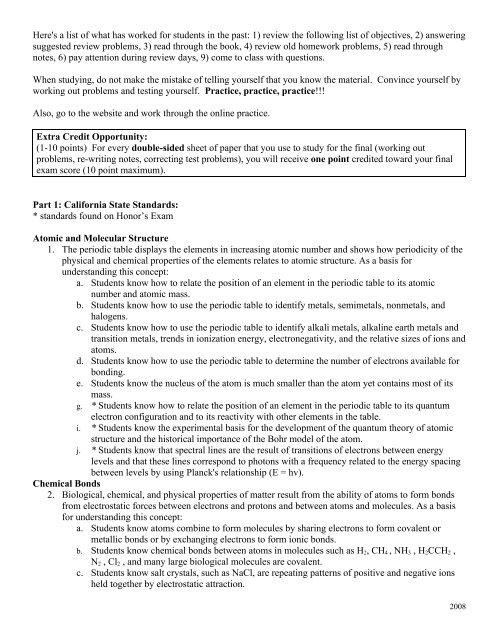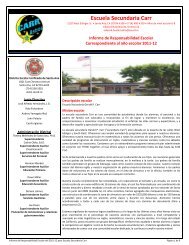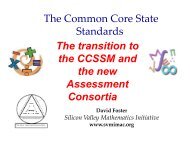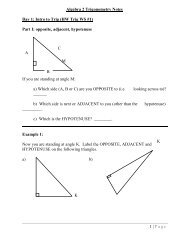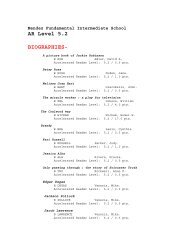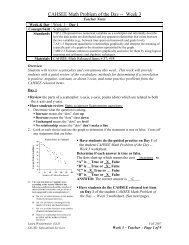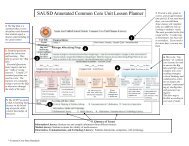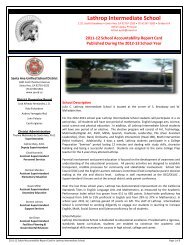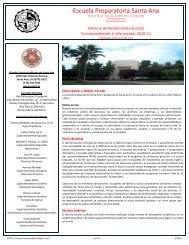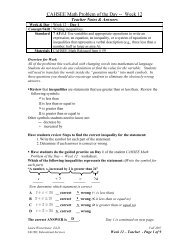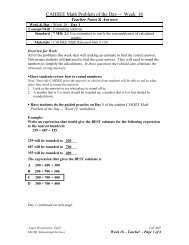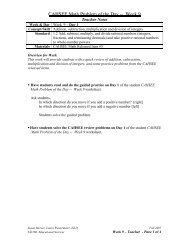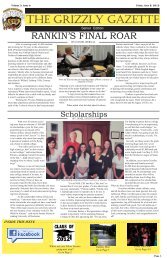You also want an ePaper? Increase the reach of your titles
YUMPU automatically turns print PDFs into web optimized ePapers that Google loves.
Here's a list of what has worked for students in the past: 1) review the following list of objectives, 2) answeringsuggested review problems, 3) read through the book, 4) review old homework problems, 5) read throughnotes, 6) pay attention during review days, 9) come to class with questions.When studying, do not make the mistake of telling yourself that you know the material. Convince yourself byworking out problems and testing yourself. Practice, practice, practice!!!Also, go to the website and work through the online practice.Extra Credit Opportunity:(1-10 points) For every double-sided sheet of paper that you use to study for the final (working outproblems, re-writing notes, correcting test problems), you will receive one point credited toward your finalexam score (10 point maximum).Part 1: California State Standards:* standards found on Honor’s ExamAtomic and Molecular Structure1. The periodic table displays the elements in increasing atomic number and shows how periodicity of thephysical and chemical properties of the elements relates to atomic structure. As a basis forunderstanding this concept:a. Students know how to relate the position of an element in the periodic table to its atomicnumber and atomic mass.b. Students know how to use the periodic table to identify metals, semimetals, nonmetals, andhalogens.c. Students know how to use the periodic table to identify alkali metals, alkaline earth metals andtransition metals, trends in ionization energy, electronegativity, and the relative sizes of ions andatoms.d. Students know how to use the periodic table to determine the number of electrons available forbonding.e. Students know the nucleus of the atom is much smaller than the atom yet contains most of itsmass.g. * Students know how to relate the position of an element in the periodic table to its quantumelectron configuration and to its reactivity with other elements in the table.i. * Students know the experimental basis for the development of the quantum theory of atomicstructure and the historical importance of the Bohr model of the atom.j. * Students know that spectral lines are the result of transitions of electrons between energylevels and that these lines correspond to photons with a frequency related to the energy spacingbetween levels by using Planck's relationship (E = hv).Chemical Bonds2. Biological, chemical, and physical properties of matter result from the ability of atoms to form bondsfrom electrostatic forces between electrons and protons and between atoms and molecules. As a basisfor understanding this concept:a. Students know atoms combine to form molecules by sharing electrons to form covalent ormetallic bonds or by exchanging electrons to form ionic bonds.b. Students know chemical bonds between atoms in molecules such as H 2 , CH 4 , NH 3 , H 2 CCH 2 ,N 2 , Cl 2 , and many large biological molecules are covalent.c. Students know salt crystals, such as NaCl, are repeating patterns of positive and negative ionsheld together by electrostatic attraction.2008
d. Students know the atoms and molecules in liquids move in a random pattern relative to oneanother because the intermolecular forces are too weak to hold the atoms or molecules in a solidform.e. Students know how to draw Lewis dot structures.f. * Students know how to predict the shape of simple molecules and their polarity from Lewis dotstructures.g. * Students know how electronegativity and ionization energy relate to bond formation.Conservation of Matter and Stoichiometry3. The conservation of atoms in chemical reactions leads to the principle of conservation of matter and theability to calculate the mass of products and reactants. As a basis for understanding this concept:a. Students know how to describe chemical reactions by writing balanced equations.b. Students know the quantity one mole is set by defining one mole of carbon 12 atoms to have amass of exactly 12 grams.c. Students know one mole equals 6.02x10 23 particles (atoms or molecules).d. Students know how to determine the molar mass of a molecule from its chemical formula and atable of atomic masses and how to convert the mass of a molecular substance to moles, numberof particles, or volume of gas at standard temperature and pressure.e. Students know how to calculate the masses of reactants and products in a chemical reactionfrom the mass of one of the reactants or products and the relevant atomic masses.f. * Students know how to calculate percent yield in a chemical reaction.Gases and Their Properties4. The kinetic molecular theory describes the motion of atoms and molecules and explains the propertiesof gases. As a basis for understanding this concept:a. Students know the random motion of molecules and their collisions with a surface create theobservable pressure on that surface.b. Students know the random motion of molecules explains the diffusion of gases.c. Students know how to apply the gas laws to relations between the pressure, temperature, andvolume of any amount of an ideal gas or any mixture of ideal gases.d. Students know the values and meanings of standard temperature and pressure (STP).e. Students know how to convert between the Celsius and Kelvin temperature scales.f. Students know there is no temperature lower than 0 Kelvin.g. * Students know the kinetic theory of gases relates the absolute temperature of a gas to theaverage kinetic energy of its molecules or atoms.h. * Students know how to solve problems by using the ideal gas law in the form PV = nRT.i. * Students know how to apply Dalton's law of partial pressures to describe the composition ofgases and Graham's law to predict diffusion of gases.Nuclear Processes11. Nuclear processes are those in which an atomic nucleus changes, including radioactive decay ofnaturally occurring and human-made isotopes, nuclear fission, and nuclear fusion. As a basis forunderstanding this concept:a. Students know protons and neutrons in the nucleus are held together by nuclear forces thatovercome the electromagnetic repulsion between the protons.b. Students know the energy release per gram of material is much larger in nuclear fusion orfission reactions than in chemical reactions. The change in mass (calculated by E = mc2 ) issmall but significant in nuclear reactions.c. Students know some naturally occurring isotopes of elements are radioactive, as are isotopesformed in nuclear reactions.d. Students know the three most common forms of radioactive decay (alpha, beta, and gamma) andknow how the nucleus changes in each type of decay.2008
Chemical Bonding• Infer the number of valence electrons using the periodic table and then construct its Lewis dot structure.• Describe the formation of a cations and anions and how to use the octet rule.• List the characteristics of an ionic bond.• List the characteristics of covalent bond.• Explain properties of ionic compounds including electrical conductivity using the metallic bondingtheory.• Describe the formation of an ionic bond.• Describe the formation of a covalent bond.• Describe double and triple bonds.• Create electron dot diagrams for covalent molecules containing single, double, and triple bonds.• *Describe the shapes of simple covalently bonded molecules using VSEPR Theory.• *Using electronegativities, categorize a bond as nonpolar covalent, polar covalent, or ionic.• Show the relationship between polar covalent bonds and polar molecules.Nomenclature (Writing and Naming Chemical Formulas)• Locate these items on the periodic table: group, period, representative element, transition element.• Define the terms cation and anion and show how they are related to the terms metal and nonmetal.• Distinguish between ionic compounds and molecular compounds.• Distinguish among chemical formula, molecular formula, and formula unit.• Infer the charge of an ion using the periodic table.• Define a polyatomic ion and recognize the names and formulas of common polyatomic ions.• Write the chemical formulas for binary ionic compounds.• Identify a binary ionic compound by name when given the formula of the compound.• Identify by name and write formulas of binary molecular compounds.Moles and Stoichiometry• Know the definition of a mole• Describe how Avogadro's number is related to a mole of any substance.• Distinguish between the terms gram atomic mass, gram molecular mass, and gram formula mass• Calculate the mass of a mole of any substance and convert between moles and mass of a substance.• Convert moles to volume and volume to moles, using the volume of one mole of a gas at STP (22.4 L).• Convert among measurements of mass, volume, and number of particles, using the mole.• *Calculate and determine the limiting reactant• *Calculate the percent composition of a substance from its chemical formula or experimental data.Gas and Their Properties• Know the Kinetic Molecular Theory and how it explain behaviors of gases• Know how to convert between temperatures and between pressures• Know the value and meaning of STP• Know the relationships between pressure, volume, and temperature of a gas using the Gas Laws(Boyle’s, Charles’s, Gay-Lussac’s, Combined)• Know how to solve problems using the ideal gas laws*-Honors Topics only2008
____ 13. To two significant figures, the measurement 0.0255 g should be reported asa. 0.02 g. c. 0.026 g.b. 0.025 g. d. 2.5 x 10 2 g.____ 14. The number of significant figures in the measurement 0.000 305 kg isa. 3. c. 5.b. 4. d. 6.____ 15. The measurement that has been expressed to three significant figures isa. 0.052 g. c. 3.065 g.b. 0.202 g. d. 5000 g.____ 16. The number of significant figures in the measurement 170.040 km isa. 3. c. 5.b. 4. d. 6.____ 17. When 64.4 is divided by 2.00, the correct number of significant figures in the result isa. 1. c. 3.b. 2. d. 4.____ 18. Divide 5.7 m by 2 m. The answer is correctly reported asa. 2.8 m. c. 2.9 m.b. 2.85 m. d. 3 m.____ 19. The product of 13 cm and 5.7 cm is correctly reported asa. 74 cm 2 . c. 74.1 cm 2 .b. 74.0 cm 2 . d. 75 cm 2 .____ 20. An ionic bond is a result ofa. sharing electrons c. deleting electronsb. trasfering electrons d. reducing electrons____ 21. A covalent bond is a result of...a. sharing electrons c. deleting electronsb. transfering electrons d. reducing electrons____ 22. An ionic bond is made of...a. two metals c. two halogensb. two nonmetals d. a metal and a nonmetal____ 23. A covalent bond is made of...a. two nonmetals c. two alkaline elementsb. two metals d. a metal and a nonmetal____ 24. A positively charged ion is also called a(n)a. anion c. monoatomic ionb. cation d. polyatomic ion____ 25. A negatively charged ion is also called a(n)a. anion c. monoatomic ionb. cation d. polyatomic ion2008
____ 26. An ion that consists of one charged atom is called a(n)a. anion c. monoatomic ionb. cation d. polyatomic ion____ 27. An ion that consists of many atoms that share a charge is called a(n)a. anion c. monoatomic ionb. cation d. polyatomic ion____ 28. The electrons involved in the formation of a chemical bond are calleda. dipoles c. Lewis electronsb. s electrons d. valence electrons____ 29. In most compounds, atoms of main-group elements form bonds so that the number of electrons inthe outermost energy levels of each atom isa. 2 c. 8b. 6 d. 10____ 30. The elements of the ____________ group have full outer energy levels without forming bonds.a. main c. alkali metalb. noble gas d. alkaline-earth metal____ 31. Molecular (covalent) compounds __________________ than ionic compounds.a. have higher boiling points c. have lower melting pointsb. are more brittle d. are harder____ 32. The partial charges formed in polar compounds are calleda. dipoles c. Lewis chargesb. ions d. valence electrons____ 33. VSEPR theory is used to determinea. which elements will bond. c. the shape of a molecule.b. the type of bond formed. d. the charge of a transition metal.____ 34. Why do atoms form chemical bonds?a. To gain energy c. To move fasterb. To become more stable d. To increase vibration____ 35. What is an ionic bond?a. the atoms share electrons evenly c. the atoms share electrons, but notevenlyb. the atoms take or give electrons d. the atoms give or take protons____ 36. Ionization energy isa. the energy needed to add an electron. c. the energy needed to remove anelectron.b. the energy needed to form a bond. d. the energy needed to break a bond.____ 37. The trend for Ionic Radius across the period wasa. Increase c. Decrease, sharply Increase thenDecreaseb. Decrease d. Stays constant.2008
____ 38. The trend for Atomic Radius across the period wasa. Increase c. Decrease, sharply Increase thenDecreaseb. Decrease d. Stays constant.____ 39. Which atomic trend determines the type of bond two atoms will form?a. Atomic Radii c. Ionization Energyb. Ionic Radii d. Electronegativity____ 40. Nonmetals tend to forma. poitive ions or cations c. positive ions or anionsb. negative ions or anions d. negative ions or cations____ 41. Metals tend to forma. poitive ions or cations c. positive ions or anionsb. negative ions or anions d. negative ions or cations____ 42. Covalent compounds are usually formed by:a. Metals and Metals c. Metals and Metalloidsb. Metals and Nonmetals d. Nonmetals and Nonmetals____ 43. Ionic compounds are usually formed by:a. Metals and Metals c. Metals and Metalloidsb. Metals and Nonmetals d. Nonmetals and Nonmetals2008
Write in Scientific NotationDetermine the number of Sig Fig44. ____________________ 550,000 _________45. ____________________ 0.000032 _________46. ____________________ 450,000,000,000,000 _________47. ____________________ 0.00000000123 _________48. ____________________ 550 _________49. ____________________ 0.0025 _________Short Answer50. Draw the Lewis Dot Structure for the following compounds. (1 point each)a) F 2 b) H 2 S c) N 2d) CBr 4 e) CO 2 f) PH 351. In the question above, which compounds will be polar? Why?53. Compare Ionic and Covalent compounds in regards to the following, and explain what causes thedifference.Melting point:Hardness:Conductivity in solution:2008
Write the formula for the following compounds55. Aluminum Sulfide ______________________________________56. Potassium Acetate ______________________________________57. Lead (III) Phosphate ______________________________________58. Iron (I) Oxide ______________________________________59. Iron (II) Oxide ______________________________________60. Sodium Carbonate ______________________________________Matchinga. kg f. mLb. g g. kmc. mg h. md. kL i. cme. L j. mm____ 61. Distance from here to Manhattan, Kansas____ 62. amount of medicine in a pill____ 63. length of this paper____ 64. amount of water used to flush the toilet____ 65. length of the football field____ 66. mass of a sumo wrestler____ 67. amount of water in a rain drop____ 68. mass of a pencila. PbSO 3 g. CaOb. PbSO 4 h. NaNO 2c. Pb 2 SO 4 i. NaNO 4d. CuI 2 j. LiOHe. CuI 3 k. FeOf. MgCl 2 l. Fe 2 O____ 69. Lead (I) sulfate____ 70. Copper (III) Iodide____ 71. Calcium oxide____ 72. Sodium pernitrate73. Lead (II) sulfite74. Magnesium chloride75. Lithium hydroxide76. Iron (I) oxide2008
Chemistry Final <strong>Review</strong> Sheet - 1st <strong>Semester</strong> Objectivesa. NO 2 g. CS 2b. P 2 H 5 h. N 2 O 3c. B 6 Si i. IF 5d. CO j. ClO 2e. SeF 6 k. CH 4f. O 2 l. Si 2 Br 6____ 77. Iodine pentaflfluoride____ 78. Selinium hexafluoried____ 79. Oxygen____ 80. Diphosphorous pentahydride____ 81. Disilicone hexabromide____ 82. Dinitrogen trioxide____ 83. Carbon tetrahydrided____ 84. Nitrogen dioxidePerform the following calculations85. How many atoms are present in 8.00 mol of chlorine atoms?86. Determine the number of moles of carbon dioxide molecules in 10.0 g of carbon dioxide (CO 2 ).87. Calculate the number of atoms in 10.0 g of sulfur.88. Calculate the number of grams in 2.71x10 24 molecules of salt (NaCl).89. 5.5 m to cm.90. 25 mg to ug91. 5 ks to s .92. .5 km to m93. .41 cm to nm94. 2.5 m to mm95. 55 mm to m
Chemistry Final <strong>Review</strong> Sheet - 1st <strong>Semester</strong> Objectives96. 550,000 mm to km97. What type of electrons are involved in a bond? ________________________________98. How many formula units are in 73.0 g of Ca(NO 3 ) 2 ?Essay Questions105. Explain the evidence that allowed Rutherford to determine the internal structure of the atom. Discussboth the nucleus and the electron cloud.Name the following compounds107. Li 2 S ____________________________________________________________________________________________108. Ca(BrO 2 ) 2 ____________________________________________________________________________________________109. PbO 2 ____________________________________________________________________________________________110. FeN ____________________________________________________________________________________________111. NaNO 3 ____________________________________________________________________________________________112. (NH 4 ) 2 SO 4 ____________________________________________________________________________________________113. Cu(ClO 4 ) 2 ____________________________________________________________________________________________114. MgCO 4 ____________________________________________________________________________________________Stoichiometry1. How many moles of O 2 should be supplied to burn 1 mol of C 3 H 8 (propane) molecules in a campingstove?2. How many moles of O 2 molecules should be supplied to burn 1 mol of CH 4 molecules in a domesticfurnace?3. Sodium thiosulfate (Na 2 S 2 O 3 ), photographer’s “hypo” reacts with unexposed silver bromide in thefilm emulsion to form sodium bromide and a compound of formula Na 5 [Ag(S 2 O 3 ) 3]. How manymoles of Na 2 S 2 O 3 formula units are needed to make 0.10 mol of AgBr soluble?4. Calculate the mass of alumina (Al 2 O 3 ) produced when 100 g of aluminum burns in oxygen.
Chemistry Final <strong>Review</strong> Sheet - 1st <strong>Semester</strong> Objectives5. “Slaked lime,” Ca(OH) 2, is formed from “quick-lime” (CaO) by adding water. What mass of wateris needed to convert 10 kg of quicklime to slaked lime? What mass of slaked lime is produced?6. Camels store the fat tristearin (C 57 H 110 O 6 ) in the hump. As well as being a source of energy, the fatis a source of water, because when it is used the reaction2 C 57 H 110 O 6 (s) + 163 O 2 (g) 114 CO 2 (g) + 110 H 2 O(l)takes place. What mass of water is available from 1.0 kg of fat?7. The compound diborane (B 2 H 6 ) was at one time considered for use as a rocket fuel. How manygrams of liquid oxygen would a rocket have to carry to burn 10 kg of diborane completely? (Theproducts of the combustion are B 2 O 3 and H 2 O.)8. Given the balanced chemical equationBr 2 + 2 NaI 2 NaBr + I 2How many moles of sodium bromide (NaBr) could be produced from 0.172 mol ofbromine (Br 2 )?9. How many formula units of calcium oxide (Cano) can be produced from 4.9 x 10 5 molecules ofoxygen gas (O 2 ) that react with calcium (Ca) according to this balanced chemical equation?2 Ca(s) + O 2 (g) 2 CaO(s)10. Aluminum metal (Al) reacts with sulfur (S) to produce aluminum sulfide (Al 2 S 3 ) according to thisbalanced chemical equation:2 Al(s) + 3 S(s) Al 2 S 3 (s)How many atoms of aluminum will react completely with 1.33 x 10 24 atoms of sulfur?11. What is the maximum mass of methane (CH 4 ) that can be burned if only 1.0 g of oxygen isavailable?12. What is the maximum mass of glucose (C 6 H 12 O 6 ) that can be burned in 10 g of oxygen?13. The solid fuel in the booster stage of the space shuttle is a mixture of ammonium perchlorate andaluminum powder, which react as follows:6 NH 4 ClO 4 (s) + 10 Al(s) 5 Al 2 O 3 (s) + 3 N 2 (g) + 6 HCl(g) + 9 H 2 O(g)What mass of aluminum should be mixed with 5.0 x 10 3 kg of ammonium perchlorate, if the reactionproceeds as stated?14. A solution containing 5.0 g of silver nitrate was mixed with another containing 5.0 g of potassiumchloride. Which was the limiting reagent for the precipitation of silver chloride?
Chemistry Final <strong>Review</strong> Sheet - 1st <strong>Semester</strong> Objectives1. Given the balanced chemical equation2 Ag + I 2 2 AgIHow many atoms of silver metal (Ag) are required to react completely with 531.8 g of iodine (I 2 ) toproduce silver iodide (AgI)?16. The theoretical yield of ammonia in an industrial synthesis was 550 tons, but only 480 tons wasobtained. What was the percentage yield of the reaction?1. Calculate the volume occupied by 16.3 moles of nitrogen gas (N 2 ) at STP.2. How many moles of fluorine gas (F 2 ) are contained in 0.269 dm 3 container at STP?3. Assuming that the gases are all at STP, find the volume of nitrogen dioxide gas (NO 2 ) that couldbe produced from 71.11 dm 3 of nitrogen gas (N 2 ) according to this balanced chemical equation.N 2 (g) + 2 O 2 (g) 2 NO 2 (g)7. A mixture of helium, neon and argon gases in a closed container at a constant volume and temperature exerts atotal pressure of 1.75 atm. If neon exerts a pressure of .50 atm and argon exerts a pressure of .75 atm, howmuch pressure does the helium gas exert?8. A weather balloon is filled with 40.5 L of helium at sea level (1.0 atm of pressure). If the balloon rises to aheight of the atmosphere where the pressure is .75 atm, what will the new volume of the balloon be? (Assumeconstant temperature).9. A 3.5 L tank of nitrogen with a pressure of 420 mm Hg is emptied into a 5.0 L tank. What will the pressure bein the new tank? (Assume constant temperature).10. At one atmosphere of pressure a weather balloon has a volume of 40.0 L at 280 K. If the temperature rises to320.0 K at a constant pressure of one atmosphere, what will the new volume of the balloon be?
Chemistry Final <strong>Review</strong> Sheet - 1st <strong>Semester</strong> Objectives11. If the volume of a weather balloon is changed from 45.0 L at 17.0 ºC to 47.0 L at the same pressure, what willthe new temperature of the balloon be?12. An aerosol can has a pressure of 1.5 atm at 17 ºC. If this can is left in a car in the hot sun and the temperaturerises to 57 ºC, what will the resulting pressure in the can be (Assume constant volume).13. The acetylene in a pressurized tank has a temperature of 7.0 ºC and a pressure of 420 mm Hg. If the pressureis increased to 550 mm Hg, what will the temperature of the gas be? Could this be dangerous? (Assumeconstant volume).14. The volume of a balloon is 250 mL at 298 K and a pressure of 1.2 atm. Calculate the new volume of theballoon if the temperature rises to 306 K and the pressure falls to 1.0 atm.15. A gas measures 250.0 mL at 20.0 ºC and 735 mm Hg. How many moles are contained in the gas?16. A 2,980 mL tank contains 11.0 g of oxygen gas. If the the temperature of the tank is 21.0 ºC, what would thepressure of the tank be?


